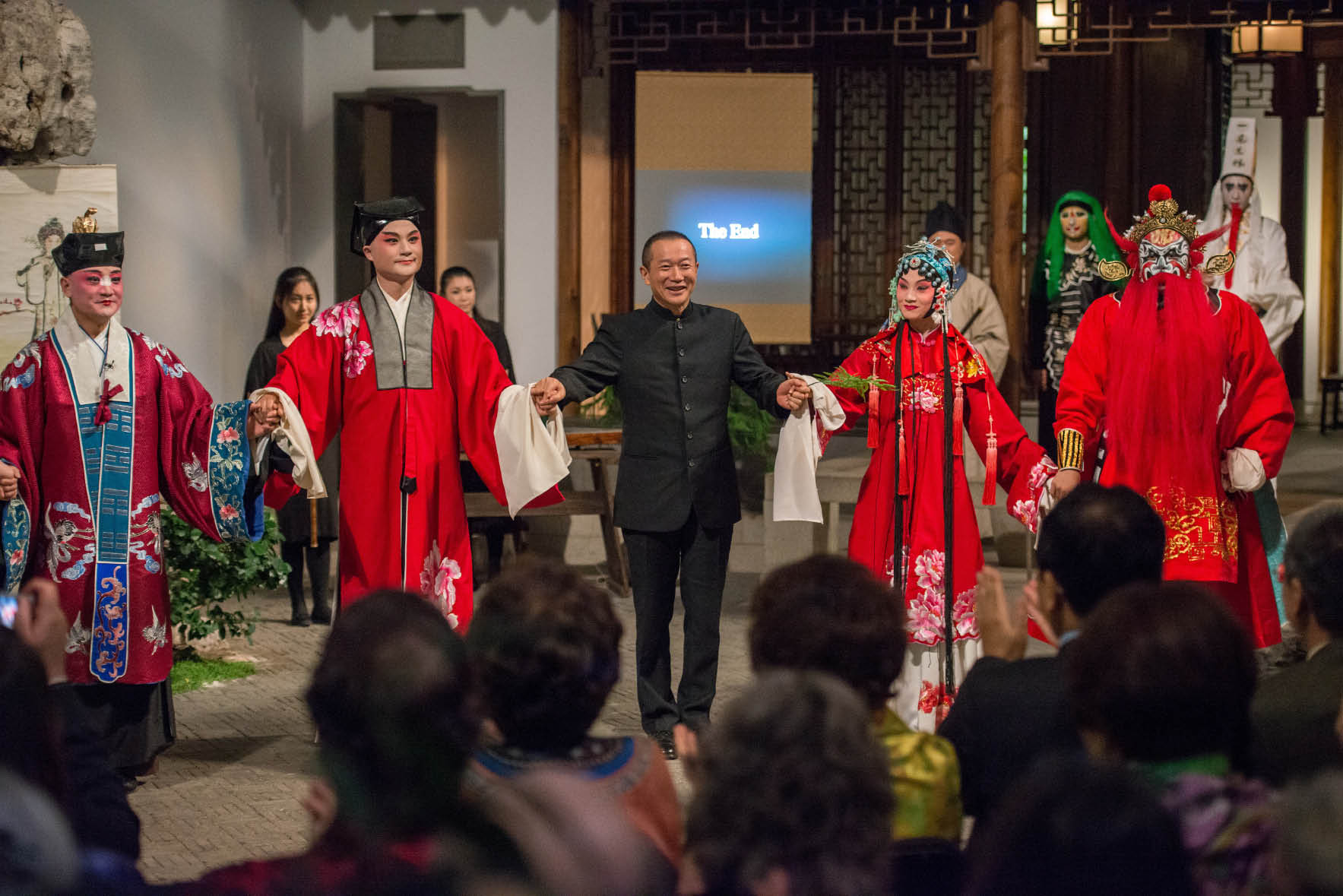Peony Pavilion at the Met
By ZHANG JUAN
 |
| Tan Dun with the cast of his garden-version Peony Pavilion in New York. |
THEATERGOERS know well that the venue is a key factor in the experience of watching a play. So when the Kunqu Opera classic Peony Pavilion was staged in the Chinese-style garden of the Metropolitan Museum of Art in New York it promised something very special for both its producers and audience.
On the night of November 30, 2012, the curtain lifted on the Kunqu Opera version of this 16th-century play directed by Oscar and Grammy winning composer Tan Dun. When it concluded 70 minutes later, the American audience gave it a standing ovation.
Kunqu’s Garden Stage
Kunqu Opera, with a history of more than 600 years, is considered to be the source of all Chinese folk operas, and was acknowledged by UNESCO as an “Oral and Intangible Heritage of Humanity,” the first Chinese cultural heritage to receive this recognition. Peony Pavilion, created by Ming Dynasty playwright Tang Xianzu (1550-1616) in 1598, remains an enduring piece in the Kunqu repertoire and has also been rendered in several other styles of folk opera.
The play tells of the strange romance between a man and a ghost. Young scholar Liu Mengmei and a magistrate’s daughter named Du Liniang meet in a dream and fall in love. Yearning for the boy she met in her dream Du buries a self-portrait beneath the rockery in a garden, and soon after the lovelorn girl dies of a broken heart.
Three years later Liu comes to this very garden and discovers the picture. This, he realizes, was the girl he had dreamt of, and later Du returns to him in his dreams. His love for this mysterious girl moves him to reopen her tomb, and as the stale air stirs, Du comes back to life. Together at last, the couple meet vehement opposition from Du’s father, but their passion prevails and the play ends with their marriage.
In recent years, as traditional Chinese operas have regained popularity among Chinese viewers, there have been several versions of this story interpreted on the stage. The most successful retelling was a youth version by Suzhou Kunqu Opera House, a 90-minute adaptation first staged in a refurbished barn belonging to the Qing imperial court in Beijing.
Tan Dun’s offering has been referred to as the “garden” version because it débuted abroad in the Met’s Astor Court, whose design is based on the 12th-century Master-of-Nets (Wangshi) Garden in Suzhou. Free of the conventional array of props and stage, the performance unfurled among natural scenery, producing a fascinating atmosphere that was both realistic and fantastical. The accompanying music, with its ingenious imitation of the sound of flowing water created by the bamboo flute, Chinese lute, zither and percussion, deepened the ethereal atmosphere of the setting.
The day before opening night Tan Dun attended “A Conversation with Tan Dun at the Met” and shared his life experiences and thoughts on creating Kunqu Opera in modern times.
At the event he recalled his first brush with the ancient art form when he was studying composition at the Central Conservatory of Music in Beijing. “One day I met with Yang Chunxia, who starred in Dujuan Mountain (one of the revolutionary Peking Opera plays officially sanctioned during the “cultural revolution”), and learnt she had actually started her career as a Kunqu Opera singer. She performed an aria from Peony Pavilion for me, and I was mesmerized. I immediately fell in love with Kunqu.”
Tan also explained his decision to set the performance in a real garden, saying that it came to him in an epiphany when he was in a traditional Chinese courtyard. As he was enjoying the sounds of birds and insects amid the babble of flowing water the peace was suddenly disrupted by a gust of wind. When it passed the music of nature returned, and he thought to himself: “Oh my, that’s Kunqu. This is why in old times the opera was staged in gardens instead of theaters.”
It was popular practice among the upper echelons of the Ming Dynasty (1368-1644) to host Kunqu performance in their private gardens, and Tan Dun sees good reason for that. “A garden, with its flora and fauna, is a medium of communication between its occupants, heaven and earth.”
Intent on offering their audience a perfect recreation of the ambience of the archetypal Chinese garden, Tan’s production team imported huge numbers of props into the U.S., including 24 purebred Chinese goldfish and recordings of birds singing in the garden on which the Astor Court was modeled.
“This retrofit of Peony Pavilion is what I envisioned in my mind, one of unsophisticated beauty as it was back in the Ming Dynasty,” Tan Dun told reporters after the performance.
Zhang Jun, who brings the play’s hero to life, said the distinctiveness of Tan’s Peony Pavilion lies in this unconventional setting. “Every garden is unique. Before performing in a new location, we would spend days studying it and modify our performance to make it fit into the surroundings. This way every group of performances at a different venue is one of a kind.”

